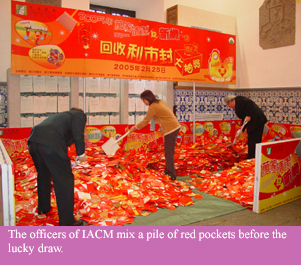|
Recycling
Red Pockets
By Jessie
Un
 The
first campaign to recycle red pockets ended successfully on February
25 as Instituto Para os Assuntos Civicos e Municipais (IACM) announced
that through this program 526,850 red pockets were collected for
recycling. The
first campaign to recycle red pockets ended successfully on February
25 as Instituto Para os Assuntos Civicos e Municipais (IACM) announced
that through this program 526,850 red pockets were collected for
recycling.
IACM
organized the "Red Pocket Recycling Program" right after
the Chinese New Year to improve the green awareness and encourage
the public participation in the waste recycling. During the holiday,
many people received a lot of lucky money while throwing away a
pile of red pockets. Through this program, the public can not only
inherit the culture of the Chinese New Year, but also protect the
environment to ensure that used red pockets would not add up to
the municipal solid waste.
Municipal
waste is a common problem in every developing or developed country.
It accumulates while our city's economy grows. The city waste has
reached the maximum capacity of incineration--320,000 tons that
the Incineration Center can handle per day, so the public demands
an immediate attention to the city's waste problem.
To
participate in the program was very simple. People just needed to
write their name and telephone numbers on their red pockets and
drop them into the red pocket collection boxes of IACM or hand them
over to associations or schools, which joined the "Red Pocket
Recycling Program". There was no limit on the number of red
pockets a person could enter in the lottery. They would have more
chance to draw a prize if they put more red pockets in the collection
box.
The
officers of IACM gathered in the IACM hall at 5 o' clock on February
25 for the lucky draw. They had to use a big spade to mix the pile
of red pockets before they drew the winning pockets (lottery). In
this campaign, 50 lottery winners were announced, who received such
prizes as a digital camera, MP3 or DVD player.
Cheong
So Mui, vice-chairman of the Affairs Commission of IACM, expressed
that the most important thing is that the campaign made all the
public realize the proper way to dispose of municipal waste.
Amy
Cheong, a Year 4 student, joined this program through the school.
Cheong said that the main reason that attracted her to this program
was that she might draw a prize. On the other hand, this program
also made her pay more attention to the waste problem. She said
that she would recycle her red pockets in the next Chinese New Year
without any prizes if she just needs to collect red pockets and
put them in the recycling box to protect the environment.
Top |